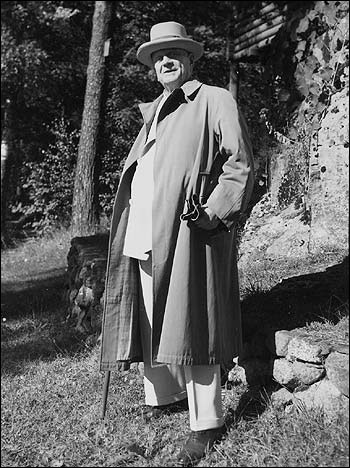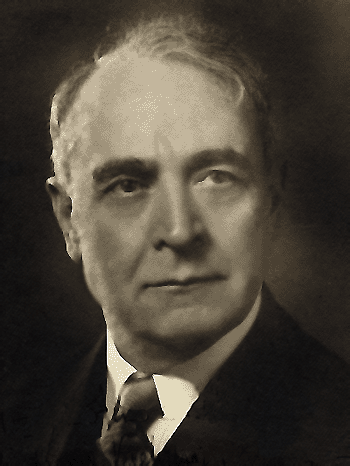Sibelius's struggle with the eighth symphony lasted for years and ended with the "great burning party" at Ainola, in which he destroyed advanced sketches of the work or even the complete work, no later than 1945.
The struggle began at the beginning of February 1928, when the composer travelled to Berlin to write "new works", apparently his eighth symphony. "My work will be wonderful. It just seems to take a long time to complete. But there is no hurry," he wrote to his wife.
At the same time, Aino Sibelius was aware of a change in the composer's nature. "It has probably done him good to go away for a while. Nowadays he is at home nearly all the time and he seldom goes to town. He has turned into a real hermit. Just imagine, Janne, who used to be so social," Aino wrote.
In the summer of 1928, in a magazine interview, Sibelius was assuming that he would continue to develop as a composer. In a conversation with the tenor Wäinö Sola he discussed a suggestion for a symphony that would describe the famous Imatra rapids, but the promised commission never came. Sibelius continued to work on the eighth symphony. "I am writing a new work, which will be sent to America. It will still need time. But it will turn out well," he wrote to his sister on the 7th September. www.mannerheim. During the year, he only completed one small choral work, The Bridge Keeper.
During 1929, Sibelius turned down profitable invitations to perform. He agreed to see Cecil Gray, who was later to write an influential book about his symphonies. Gray found it hard to adapt to the ways of Finnish hospitality, where lunches merged into dinners and dinners into lunches.
In the same year, Sibelius wrote his opus 115 for violin and piano, the five sketches of opus 114 and a light suite for violin and orchestra. He planned an opus 117 for the suite, but he finally decided to leave the work unpublished, as the first publisher he approached did not seize the opportunity. The suite was not published until the 1980s. This was the last year in which he offered several new works to publishers.
Sibelius was seen in public less and less. He was interested in the ardently anti-communist Lapua Movement in its early stages, and he followed the arrival of the "Peasants' March" in Helsinki, which was a festive occasion. Later Sibelius became alienated from the movement, which had moved towards extremism and organised the violent abduction of prominent figures who were considered too leftist. In 1930 the only sign that Sibelius was still interested in composition was Karelia's Fate, a piece for male choir and piano. It was the only work that he completed in that year.

Jean Sibelius at Ainola in the 1930s.
The year 1931 produced a charming piano duet, Rakkaalle Ainolle (For My Dear Aino), for his wife's 60th birthday, and the organ work Surusoitto for Akseli Gallen-Kallela's funeral. Its ascetic atmosphere and modern style of expression seemed to portend yet another change in the composer's style.
The eighth symphony, too, progressed in 1931. Sibelius was working on it in May while he was in Berlin. He was in a good working mood. "The symphony is advancing with rapid strides," he wrote. The working mood was interrupted by an illness which the doctors diagnosed as "pulmonary pleuritis". Using an experimental treatment, Professor Zuelzer injected Sibelius with the medicine Eutoton, which brought the composer close to death's door. When the experiment was interrupted, he recovered, but his zest for composition had faded.
In the middle of June, Sibelius returned home from his last trip abroad. The eighth symphony was still unfinished, but in August, in a letter to Serge Koussevitzky, he wrote that he thought the work would be completed by 1932. Towards the end of the year, the work seemed to progress very well. "I am writing my eighth symphony and I am full of youth. How can this be explained?" Sibelius marvelled on the 18th December. However, in January 1932, Sibelius sent Koussevitzky the bad news: "No symphony this season."

Serge Koussevitzky (1874-1951).
The interesting correspondence between the composer and the conductor continued. In June 1932, Sibelius wrote that he hoped that Koussevitzky could conduct the work at the end of October! In July, he informed the conductor that he was not sure whether he could complete the work by October, "as there have been all kinds of interruptions to my work".
During the same summer, there was change of leadership in the Helsinki Philharmonic Orchestra. Robert Kajanus had left his post on the 28th May after conducting the orchestra's 50-year jubilee concert. Now 60-year-old Georg Schnéevoigt, Kajanus's mortal enemy, was chosen as his successor.
Kajanus left the orchestra in a bitter mood. He had held on till the last moment: a few months later a problem with his foot was giving him terrible pain and preventing him from moving. But with almost his last ounce of strength he travelled to London in June to record Tapiola, the fifth symphony, Pohjola's Daughter, the orchestral suite Belshazzar's Feast and the third symphony with the London Symphony Orchestra. Kajanus oli tehnyt maailmanhistorian ensimmäiset levytykset Sibeliuksen sinfonioista vain pari vuotta aikaisemmin, toukokuussa 1930. Silloin oli purkitettu ensimmäinen ja toinen sinfonia sekä Karelia-sarja.
Sibelius was moderately satisfied with the recordings, although he thought that they did not represent Kajanus at his best. "When I speak of these recordings I should mention that the conductors who have most faithfully followed the tempi I asked for are K. (and also Toscanini)," Sibelius later disclosed.
He had nothing against Schnéevoigt either. Schnéevoigt telephoned him just before a press conference at the beginning of the autumn season of 1932, and Sibelius promised him the first public performance in Finland of the eighth symphony, for the spring season of 1933. However, he reminded Schnéevoigt that the first public performance had been promised to Koussevitzky in Boston, and the first public performance in Europe to Basil Cameron and the Royal Philharmonic Society in London.
The work may have been almost complete in October 1932, when Sibelius wrote to Koussevitzky saying that he would try to send him at least a handwritten score before December, or the printed material a few months later.
Koussevitzky conducted Tapiola with tremendous success in Boston in November 1932, and he started a concert series which included all Sibelius's symphonies. He hoped to be able to crown the series of spring 1933 with the first public performance of the eighth symphony. In December, the composer, who was approaching the age of 67, was sipping brandy with Schnéevoigt and chatting about his symphony. "Du vet inte hur genial det är" (you have no idea how brilliant it is), Sibelius boasted.
On 17th January 1933 Sibelius gave Koussevitzky an unpleasant surprise: "Sorry impossible this season." The symphony, which was supposed to be completed in the autumn, was now so unfinished that the composer did not think it would be ready even in May! Had the composition plan changed? Had Sibelius abandoned large parts of the symphony?
Sibelius was not discouraged. A diary note of 4th May 1933 shows that the work on the composition was going well. "It is as if I had come home. In my art. I'm working on the first movement, in other words, I'm forging it. I'm taking everything in another way, more deeply. A gypsy within me. Romantic."
In the summer of 1933 Sibelius was still confident. He told the journalist Bob Davis that the eighth symphony would soon be completed. "It will be the reckoning of my whole existence - sixty-eight years. It will probably be my last. Eight symphonies and a hundred songs. It has to be enough," he said.
A receipt confirms that the eighth symphony was already at the transcription stage in the summer of 1933. At the beginning of September, Sibelius's copyist Paul Voigt actually sent 23 pages of the score of the eighth symphony to Sibelius, who expressed his satisfaction and wrote: "There should be a fermata at the end. The Largo continues directly. The whole work will be about eight times as long as this."
Sibelius continued his struggle to put the finishing touches to the eighth symphony, but after 1933 there were no more encouraging statements about the symphony being completed quickly.

